The Global Table
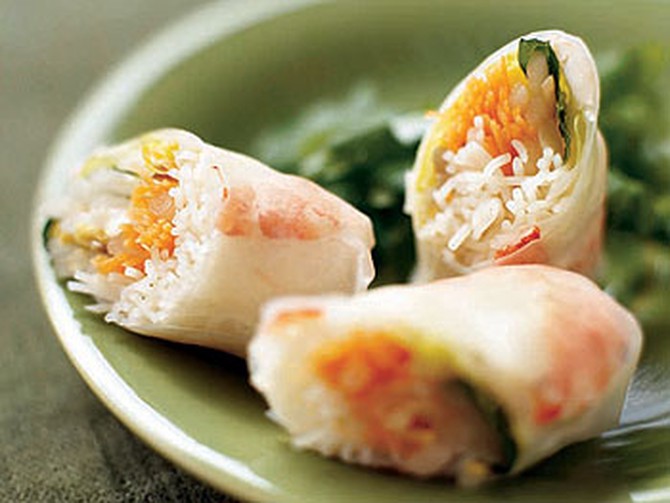
Vietnamese
The fragrant, light food of Vietnam is often referred to as the nouvelle cuisine of Asian cooking. Dishes use very little added fat and are accompanied by lettuce leaves, slivers of pickled vegetables and fresh herbs such as mint and Asian basil.
On every Table: The indispensable condiment is nuoc cham, a spiced and sweetened fish sauce. It might have a pronounced salty flavor, depending on how "fishy" the restaurant makes it.
Dive in: Pho is a steaming beef-broth-and-noodle soup to which you add your own seasonings, like fresh lime, jalapeños, bean sprouts, and red chilies. Eat the floating ingredients with chopsticks and use a spoon for the broth. Don't worry if you can't finish every drop—all that liquid is there to keep everything else warm.
Best bites: Fried spring rolls called cha gio, stuffed with a pork mixture, and summer rolls called goi cuon, a steamed version, stuffed with shrimp and rice vermicelli.
Game plan: Nem nuong are grilled spiced pork meatballs that come with moist, thin rice-paper wrappers. Place one delicate paper round on your palm, positioning a small piece of meat and a bit of salad in the center. Fold the edges over the filling and roll up the wrapper, then dip it in peanut or red chili sauce.
On every Table: The indispensable condiment is nuoc cham, a spiced and sweetened fish sauce. It might have a pronounced salty flavor, depending on how "fishy" the restaurant makes it.
Dive in: Pho is a steaming beef-broth-and-noodle soup to which you add your own seasonings, like fresh lime, jalapeños, bean sprouts, and red chilies. Eat the floating ingredients with chopsticks and use a spoon for the broth. Don't worry if you can't finish every drop—all that liquid is there to keep everything else warm.
Best bites: Fried spring rolls called cha gio, stuffed with a pork mixture, and summer rolls called goi cuon, a steamed version, stuffed with shrimp and rice vermicelli.
Game plan: Nem nuong are grilled spiced pork meatballs that come with moist, thin rice-paper wrappers. Place one delicate paper round on your palm, positioning a small piece of meat and a bit of salad in the center. Fold the edges over the filling and roll up the wrapper, then dip it in peanut or red chili sauce.
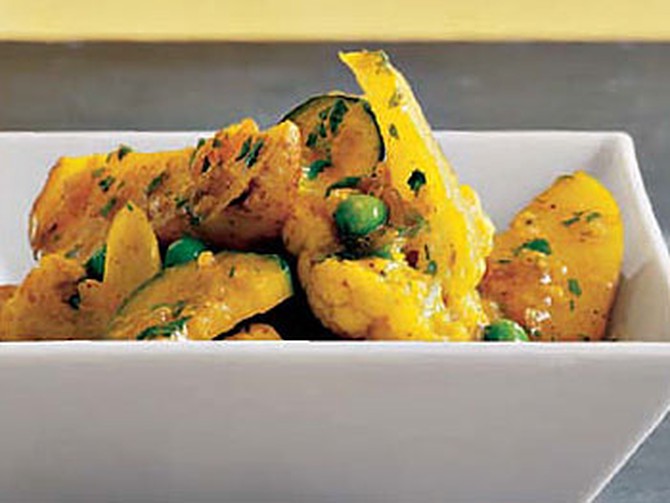
Indian
It's tough to shorthand the diverse cooking of the subcontinent, but some things remain constant: There will be very little beef and even less pork, and a good number of vegetarian options, such as panir makhni, cubes of Indian farmer cheese cooked in tomato sauce, and dal, made of peas, lentils, or beans.
Underneath it all: Suffusing every curry (a soupy meat or vegetable stew) is garam masala, a wildly variable aromatic spice mix with heat provided by red chilies, black pepper, and sometimes ginger (you can order it mild if you wish). A quick cooldown comes from fluffy basmati rice and raita, a condiment typically made of yogurt-dressed cucumber.
Beginners: If you're not an intrepid eater, go for chicken tandoori (the spice paste that turns it a bright orange-red is familiar enough to remind you of barbecued chicken but sufficiently exotic to introduce you to Indian flavors) or biryani, a tasty rice casserole.
Hot flash: Beware the ominous sounding vindaloo, a particularly fiery curry.
Try this recipe: Mild Vegetable Curry with Earl Grey Rice
Underneath it all: Suffusing every curry (a soupy meat or vegetable stew) is garam masala, a wildly variable aromatic spice mix with heat provided by red chilies, black pepper, and sometimes ginger (you can order it mild if you wish). A quick cooldown comes from fluffy basmati rice and raita, a condiment typically made of yogurt-dressed cucumber.
Beginners: If you're not an intrepid eater, go for chicken tandoori (the spice paste that turns it a bright orange-red is familiar enough to remind you of barbecued chicken but sufficiently exotic to introduce you to Indian flavors) or biryani, a tasty rice casserole.
Hot flash: Beware the ominous sounding vindaloo, a particularly fiery curry.
Try this recipe: Mild Vegetable Curry with Earl Grey Rice
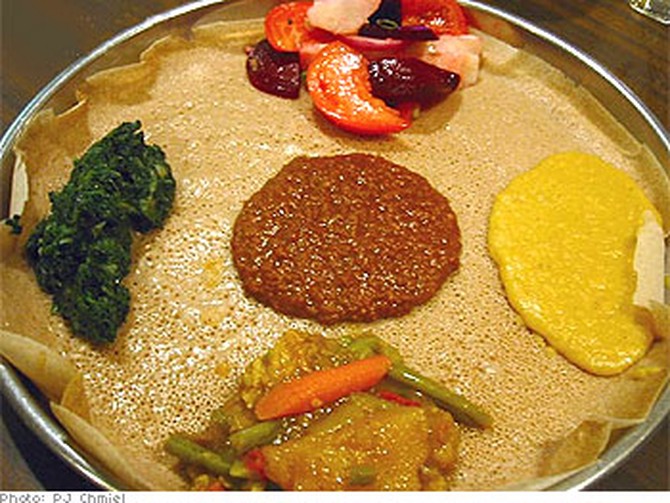
Ethiopian
Any meal you order will feature injera, a slightly spongy flat bread that tastes a bit like sourdough and is used as fork, spoon, and serving platter.
Instant expert: Using your right hand, tear off a piece of injera and scoop up some wat—vegetable or meat stew—or small chunks of grilled or sautéed meat called tibs. The specialty might be doro wat, a peppery stew of chicken legs, traditionally served with hard-boiled eggs.
Totally hot: If that's how you like it, try wat seasoned with the intense red-pepper blend called berbere. If not, look for milder alicha wat, flavored with turmeric, which gives the stew a yellow color, more like curry.
A helping hand: Placing a bite of food in a friend's mouth (with the right hand—never the left!) is a gesture of fellowship.
Instant expert: Using your right hand, tear off a piece of injera and scoop up some wat—vegetable or meat stew—or small chunks of grilled or sautéed meat called tibs. The specialty might be doro wat, a peppery stew of chicken legs, traditionally served with hard-boiled eggs.
Totally hot: If that's how you like it, try wat seasoned with the intense red-pepper blend called berbere. If not, look for milder alicha wat, flavored with turmeric, which gives the stew a yellow color, more like curry.
A helping hand: Placing a bite of food in a friend's mouth (with the right hand—never the left!) is a gesture of fellowship.
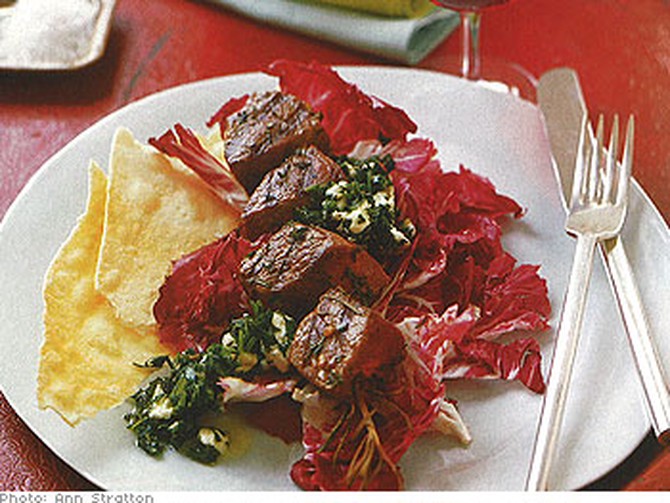
Turkish
Turkey straddles Asia and Europe, and its cooking blends both worlds: Eastern aromatic spices mix with Mediterranean herbs.
Crash course: Dolma, which means "stuffed," is the key to decoding dishes such as dolmades (stuffed grape leaves) and biber dolma (green pepper filled with spiced rice or meat). Kebab means "roasted"—skewered cubes of meat are called shish kebab, and döner kebab is layers of lamb stacked on a vertical rotating spit and sliced off in long, thin pieces as the exterior crisps. These dishes are accompanied by pilaf, a flavorful grain dish made with rice or bulgur (cracked wheat).
National specialty: Imam bayildi, a stuffed eggplant simmered in olive oil and so delicious that its name translates as "the imam [priest] fainted."
Try these recipes:
Crash course: Dolma, which means "stuffed," is the key to decoding dishes such as dolmades (stuffed grape leaves) and biber dolma (green pepper filled with spiced rice or meat). Kebab means "roasted"—skewered cubes of meat are called shish kebab, and döner kebab is layers of lamb stacked on a vertical rotating spit and sliced off in long, thin pieces as the exterior crisps. These dishes are accompanied by pilaf, a flavorful grain dish made with rice or bulgur (cracked wheat).
National specialty: Imam bayildi, a stuffed eggplant simmered in olive oil and so delicious that its name translates as "the imam [priest] fainted."
Try these recipes:
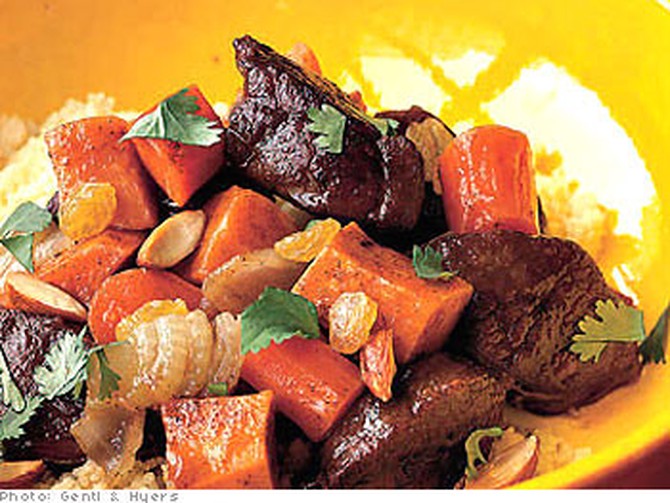
Moroccan
This North African country's cooking features exotic spices, such as star anise and clove, typically associated with desserts.
Signature style: Dishes often mix savory with sweet, like chicken b'stilla (shredded chicken with onions and almonds wrapped in a sugar-and-cinnamon-dusted pastry) or lamb and apricot tagine (stew cooked in a ceramic dish).
It's everywhere: Lamb is the meat of choice, served roasted or as a skewered sausage-shaped meatball called kefta.
Insider info: Because Moroccan food is traditionally eaten with the thumb and first two fingers of the right hand (and yes, even meatballs may be eaten this way), your meal could start and end with a wet towel.
Try these recipes:
Signature style: Dishes often mix savory with sweet, like chicken b'stilla (shredded chicken with onions and almonds wrapped in a sugar-and-cinnamon-dusted pastry) or lamb and apricot tagine (stew cooked in a ceramic dish).
It's everywhere: Lamb is the meat of choice, served roasted or as a skewered sausage-shaped meatball called kefta.
Insider info: Because Moroccan food is traditionally eaten with the thumb and first two fingers of the right hand (and yes, even meatballs may be eaten this way), your meal could start and end with a wet towel.
Try these recipes:
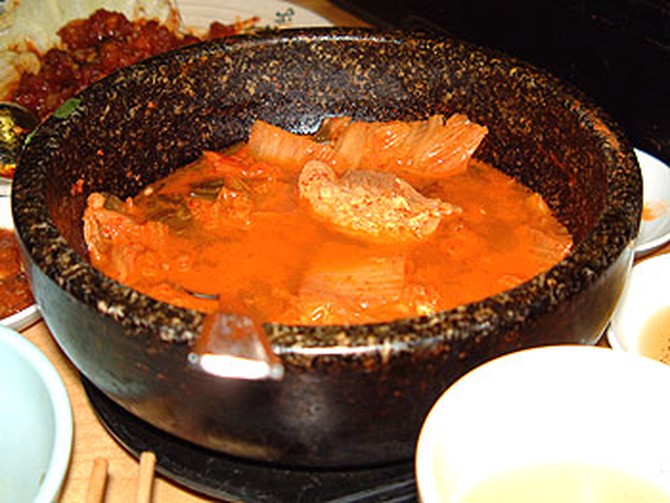
Korean Cuisine
Korean
The national dish is kimchi—pickled vegetables. Each year in anticipation of winter, Koreans prepare this spicy-hot food in a ritual called kimjang.
House rule: Rice is a mainstay, typically eaten with a spoon, not chopsticks.
Will work for food: In traditional Korean barbecue, a charcoal brazier is brought to your table (if it's not already built in) for you to cook bulgogi (beef strips), bulgabi (short ribs), or dwaeji galbi (pork ribs), served with lettuce leaves. It's considered rude to make a burrito-size portion by rolling a pile of meat in a whole leaf. Instead, tear off a small piece for a bite-size sandwich. The taste will be a distinctive combination of sweet, sour, peppery, and smoky.
Big bowls: Spoon up a soup like kori kom tang, made with oxtails, or bibimbap, a mixture of rice, meat and vegetables topped with an egg.
The national dish is kimchi—pickled vegetables. Each year in anticipation of winter, Koreans prepare this spicy-hot food in a ritual called kimjang.
House rule: Rice is a mainstay, typically eaten with a spoon, not chopsticks.
Will work for food: In traditional Korean barbecue, a charcoal brazier is brought to your table (if it's not already built in) for you to cook bulgogi (beef strips), bulgabi (short ribs), or dwaeji galbi (pork ribs), served with lettuce leaves. It's considered rude to make a burrito-size portion by rolling a pile of meat in a whole leaf. Instead, tear off a small piece for a bite-size sandwich. The taste will be a distinctive combination of sweet, sour, peppery, and smoky.
Big bowls: Spoon up a soup like kori kom tang, made with oxtails, or bibimbap, a mixture of rice, meat and vegetables topped with an egg.
From the August 2005 issue of O, The Oprah Magazine

